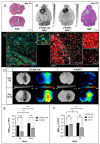The Traumatic Inoculation Process Affects TSPO Radioligand Uptake in Experimental Orthotopic Glioblastoma
- PMID: 38255293
- PMCID: PMC10813339
- DOI: 10.3390/biomedicines12010188
The Traumatic Inoculation Process Affects TSPO Radioligand Uptake in Experimental Orthotopic Glioblastoma
Abstract
Background: The translocator protein (TSPO) has been proven to have great potential as a target for the positron emission tomography (PET) imaging of glioblastoma. However, there is an ongoing debate about the potential various sources of the TSPO PET signal. This work investigates the impact of the inoculation-driven immune response on the PET signal in experimental orthotopic glioblastoma.
Methods: Serial [18F]GE-180 and O-(2-[18F]fluoroethyl)-L-tyrosine ([18F]FET) PET scans were performed at day 7/8 and day 14/15 after the inoculation of GL261 mouse glioblastoma cells (n = 24) or saline (sham, n = 6) into the right striatum of immunocompetent C57BL/6 mice. An additional n = 25 sham mice underwent [18F]GE-180 PET and/or autoradiography (ARG) at days 7, 14, 21, 28, 35, 50 and 90 in order to monitor potential reactive processes that were solely related to the inoculation procedure. In vivo imaging results were directly compared to tissue-based analyses including ARG and immunohistochemistry.
Results: We found that the inoculation process represents an immunogenic event, which significantly contributes to TSPO radioligand uptake. [18F]GE-180 uptake in GL261-bearing mice surpassed [18F]FET uptake both in the extent and the intensity, e.g., mean target-to-background ratio (TBRmean) in PET at day 7/8: 1.22 for [18F]GE-180 vs. 1.04 for [18F]FET, p < 0.001. Sham mice showed increased [18F]GE-180 uptake at the inoculation channel, which, however, continuously decreased over time (e.g., TBRmean in PET: 1.20 at day 7 vs. 1.09 at day 35, p = 0.04). At the inoculation channel, the percentage of TSPO/IBA1 co-staining decreased, whereas TSPO/GFAP (glial fibrillary acidic protein) co-staining increased over time (p < 0.001).
Conclusion: We identify the inoculation-driven immune response to be a relevant contributor to the PET signal and add a new aspect to consider for planning PET imaging studies in orthotopic glioblastoma models.
Keywords: TSPO PET and autoradiography; glioblastoma; immunohistochemistry; orthotopic implantation; traumatic brain injury (TBI).
Conflict of interest statement
The authors declare no competing interests. M.B. received speaker honoraria from GE healthcare, Roche and LMI and is an advisor of LMI and MIAC. N.L.A. has received honoraria for consultation or advisory board participation from Novartis/Advanced Accelerator Applications, Telix Pharmaceuticals and Servier and research funding from Novocure. A.H. is an advisor of ABX advanced biochemical compounds.
Figures





Similar articles
-
Longitudinal [18F]GE-180 PET Imaging Facilitates In Vivo Monitoring of TSPO Expression in the GL261 Glioblastoma Mouse Model.Biomedicines. 2022 Mar 22;10(4):738. doi: 10.3390/biomedicines10040738. Biomedicines. 2022. PMID: 35453488 Free PMC article.
-
18 kDa translocator protein positron emission tomography facilitates early and robust tumor detection in the immunocompetent SB28 glioblastoma mouse model.Front Med (Lausanne). 2022 Oct 17;9:992993. doi: 10.3389/fmed.2022.992993. eCollection 2022. Front Med (Lausanne). 2022. PMID: 36325388 Free PMC article.
-
11C-DPA-713 Versus 18F-GE-180: A Preclinical Comparison of Translocator Protein 18 kDa PET Tracers to Visualize Acute and Chronic Neuroinflammation in a Mouse Model of Ischemic Stroke.J Nucl Med. 2019 Jan;60(1):122-128. doi: 10.2967/jnumed.118.209155. Epub 2018 Jul 5. J Nucl Med. 2019. PMID: 29976695 Free PMC article.
-
TSPO PET, tumour grading and molecular genetics in histologically verified glioma: a correlative 18F-GE-180 PET study.Eur J Nucl Med Mol Imaging. 2020 Jun;47(6):1368-1380. doi: 10.1007/s00259-019-04491-5. Epub 2019 Sep 5. Eur J Nucl Med Mol Imaging. 2020. PMID: 31486876
-
Recent developments on PET radiotracers for TSPO and their applications in neuroimaging.Acta Pharm Sin B. 2021 Feb;11(2):373-393. doi: 10.1016/j.apsb.2020.08.006. Epub 2020 Aug 25. Acta Pharm Sin B. 2021. PMID: 33643818 Free PMC article. Review.
References
-
- Weller M., van den Bent M., Preusser M., Le Rhun E., Tonn J.C., Minniti G., Bendszus M., Balana C., Chinot O., Dirven L., et al. EANO guidelines on the diagnosis and treatment of diffuse gliomas of adulthood. Nat. Rev. Clin. Oncol. 2021;18:170–186. doi: 10.1038/s41571-020-00447-z. - DOI - PMC - PubMed
Grants and funding
LinkOut - more resources
Full Text Sources
Miscellaneous

